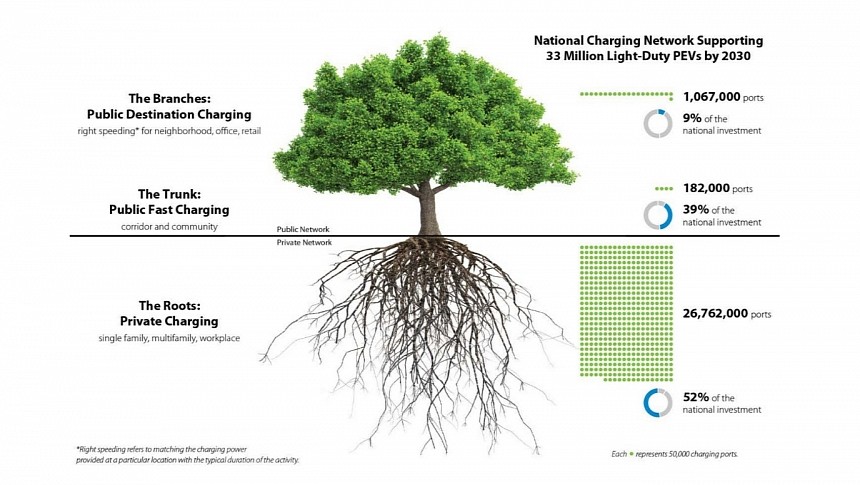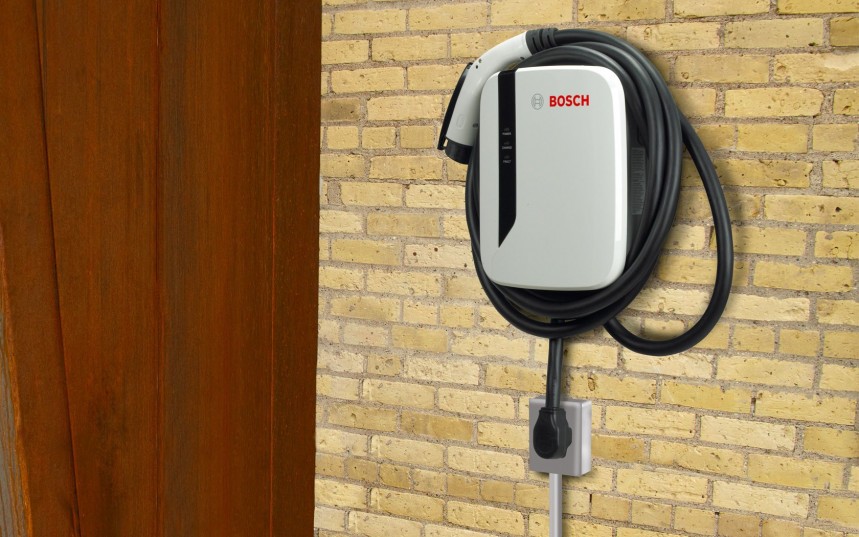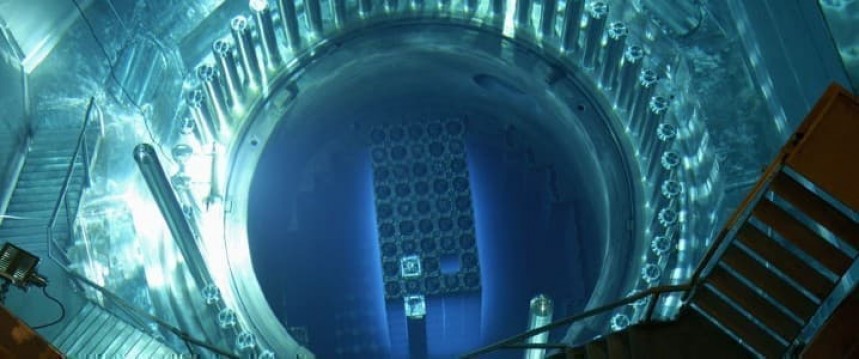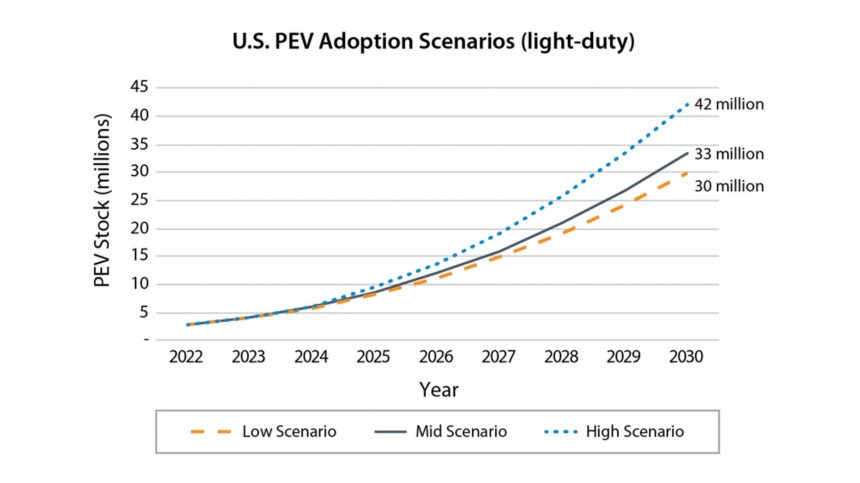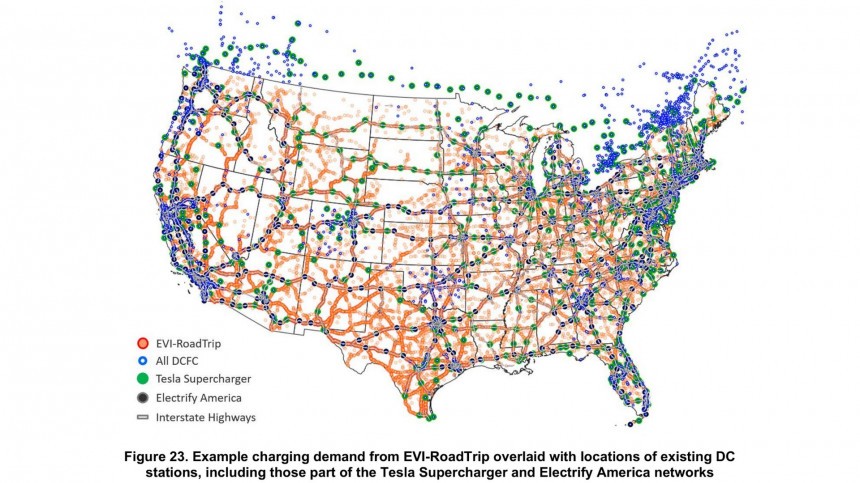The push for people to buy battery electric vehicles (BEVs) is coming from all sources. Governments think that will help them achieve the Paris Agreement goal of being carbon neutral by 2050. Pushed by legislators, automakers also want customers to buy what they are forced to produce. Some argue that they need infrastructure to commit to BEV sales. The National Renewable Energy Laboratory (NREL) calculated how many chargers the US will need if it achieves an electric fleet of 33 million cars: that's 28 million charging ports.
Those familiar with charging stall numbers in that country will think America is way off where it should be. However, NREL's calculation includes home chargers and public charging ports that are not fast, so the number gets much less scary. According to the laboratory, it would be necessary to have 182,000 fast chargers, 1 million Level 2 public charging stalls, and 26.8 million private Level 1 and Level 2 charging ports. In other words, the vast majority of these 28 million chargers would be in people's homes or their workplaces.
This illustrates pretty well how the government expects electric cars to play their roles. They are supposed to be charged chiefly at home and at night. Due to their large battery packs, Level 1 chargers will take several hours to "top up" their high-voltage accumulators, which will lead most BEV owners to choose Level 2 chargers. They will demand a reasonable investment on top of what the BEV purchase already requires: not only on the equipment itself, but also on preparing their homes for these devices.
The study also talks about the people who will not be able to charge their BEVs at home. For these customers, NREL believes fast chargers will help them keep running their cars, just like all the people with combustion-engined cars do when they visit fuel stations. However, there are three major differences between these folks. The first is that an ICE vehicle will not take half an hour to reach 80% of its tank capacity. The second is that constant refueling will not damage this reservoir. Finally, if the fuel tank is damaged, it will not demand $20,000 for a replacement. All that is true for BEVs and their battery packs, but the study does not address that: it just takes electric cars as a hassle-free solution.
There are debates about how this home charging demand will keep energy production going at night. If all cars are BEVs, peak energy consumption will happen while people sleep. Nowadays, that time is used for power plants' maintenance. Unless hydropower is available everywhere – which it isn't – there are only a few ways that this electricity will come from carbon-neutral sources.
Nuclear energy is the primary option for that to happen. Those who are against it will need to install massive battery packs close to wind or solar farms to store the energy these power plants can harvest during the day. Considering the current structure of most power grids, that electricity should come from coal or gas power plants. That is seen by BEV detractors as incoherence, which is undeniable when it comes to carbon emissions. If the goal is to get rid of fossil fuels, electricity generation needs to be included.
Suppose all energy comes from carbon-neutral sources. Even if that is the case by 2030, the necessary infrastructure for 33 million BEVs will demand massive investments. NREL also calculated that and determined that the US would need up to $127 billion for the task. In fact, the laboratory did not disclose precise values, only estimates that depend on how many BEVs will be running by the end of this decade.
NREL established 33 million as a mid-adoption scenario. In fact, the lab estimated BEVs may range from 30 million to 42 million by 2030. With these numbers, the true mid-adoption scenario would be 36 million, but NREL probably thought it would be better to bet on a lower figure. For 30 million electric cars, the lowest investment would be around $53 billion. For 46 million vehicles, the highest number would be $127 million. The laboratory broke down these calculations into the three categories it created.
Home and office chargers would need something between $22 billion and $72 billion. The fast-charging stalls could cost between $27 billion and $44 billion, while the public Level 2 chargers would demand between $5 billion and $11 billion. Predictably, most of that money will come from BEV owners. If you think it through, that will only not be the case directly for fast chargers and public Level 2 chargers, but electric car buyers will eventually pay for that as well.
The laboratory said that it did not include the money that "grid upgrades and distributed energy resources" will demand because that was not the scope of the study. It also explains how the calculations were made and under which methods. Should you be interested in these details, you can check them in the PDF included here.
According to the document, the scope of the report is to "supports the vision of the Joint Office (of Energy and Transportation) by presenting a quantitative needs assessment for a national charging network capable of supporting 30–42 million PEVs on the road by 2030." This vision anticipates "a national charging network that is convenient, affordable, reliable, and equitable to enable a future where everyone can ride and drive electric."
The NREL did not question at any moment if BEVs are the right way to "drive electric," the implications and investments they will demand, or the long-term consequences. Again, it would not be the scope of the study, but it should be. Otherwise, governments and automakers will only drive customers to a situation that is not affordable, sustainable, or equitable: BEVs are rich people's toys without a feasible plan for battery pack replacements. That will limit their reach and make people stick to their older and more polluting ICE vehicles. In other words, Paris Agreement's objectives may remain unattainable.
This illustrates pretty well how the government expects electric cars to play their roles. They are supposed to be charged chiefly at home and at night. Due to their large battery packs, Level 1 chargers will take several hours to "top up" their high-voltage accumulators, which will lead most BEV owners to choose Level 2 chargers. They will demand a reasonable investment on top of what the BEV purchase already requires: not only on the equipment itself, but also on preparing their homes for these devices.
There are debates about how this home charging demand will keep energy production going at night. If all cars are BEVs, peak energy consumption will happen while people sleep. Nowadays, that time is used for power plants' maintenance. Unless hydropower is available everywhere – which it isn't – there are only a few ways that this electricity will come from carbon-neutral sources.
Suppose all energy comes from carbon-neutral sources. Even if that is the case by 2030, the necessary infrastructure for 33 million BEVs will demand massive investments. NREL also calculated that and determined that the US would need up to $127 billion for the task. In fact, the laboratory did not disclose precise values, only estimates that depend on how many BEVs will be running by the end of this decade.
Home and office chargers would need something between $22 billion and $72 billion. The fast-charging stalls could cost between $27 billion and $44 billion, while the public Level 2 chargers would demand between $5 billion and $11 billion. Predictably, most of that money will come from BEV owners. If you think it through, that will only not be the case directly for fast chargers and public Level 2 chargers, but electric car buyers will eventually pay for that as well.
According to the document, the scope of the report is to "supports the vision of the Joint Office (of Energy and Transportation) by presenting a quantitative needs assessment for a national charging network capable of supporting 30–42 million PEVs on the road by 2030." This vision anticipates "a national charging network that is convenient, affordable, reliable, and equitable to enable a future where everyone can ride and drive electric."
The NREL did not question at any moment if BEVs are the right way to "drive electric," the implications and investments they will demand, or the long-term consequences. Again, it would not be the scope of the study, but it should be. Otherwise, governments and automakers will only drive customers to a situation that is not affordable, sustainable, or equitable: BEVs are rich people's toys without a feasible plan for battery pack replacements. That will limit their reach and make people stick to their older and more polluting ICE vehicles. In other words, Paris Agreement's objectives may remain unattainable.
